Marketing icon “Dino” and Jurassic friends first appeared at 1933 World’s Fair in Chicago.
Harry Ford Sinclair establish his petroleum company in 1916, making it one of the oldest continuous names in the U.S. energy industry. Appearing among other Sinclair Oil Company dinosaurs during the 1933-1934 World’s Fair in Chicago, “Dino” quickly became a marketing icon whose popularity – and educational value – with children remains today.
With $50 million in assets, Harry Ford Sinclair borrowed another $20 million and formed Sinclair Oil & Refining Corporation on May 1, 1916. Sinclair brought together a collection of several depressed oil properties, five small refineries and many untested leases-all acquired at bargain prices.

Today known more correctly as Apatosaurus, in the 1960s a 70-foot “Dino” traveled more 10,000 miles through 25 states – stopping at shopping centers and other venues where children were introduced to the wonders of the Mesozoic era courtesy of Sinclair Oil.
In its first 14 months, Sinclair’s New York-based company produces six million barrels of oil for a net income of almost $9 million. The company’s refining capacity grew from 45,000 barrels of oil a day in 1920 to 100,000 barrels of oil a day in 1926. Refining capacity reached 150,000 barrels of oil per day in 1932.
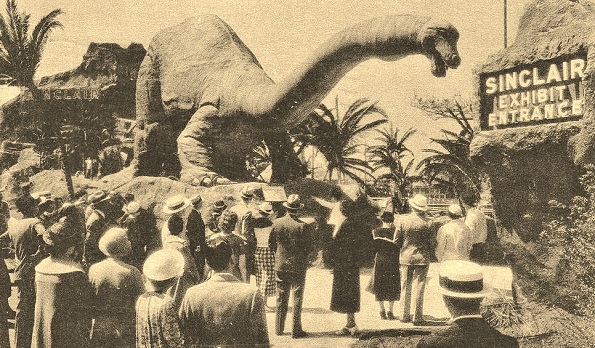
The first Sinclair Oil “Brontosaurus” trademark made its debut in Chicago as an exhibit during the 1933-1934 “Century of Progress” World’s Fair.
The prospering producing and refining company began using an Apatosaurus (then called a Brontosaurus) in its advertising, sales promotions and product labels in 1930. Children loved it. Excited crowds gathered at Sinclair Oil Company dinosaurs exhibit during the Century of Progress International Exposition, also known as the Chicago World’s Fair, from May 27, 1933, to October 31, 1934.
Sinclair Oil Company dinosaurs
As Sinclair’s dinosaur exhibit attracted Depression Era crowds. the company published a special edition newspaper, Big News, promoting the company’s diverse array of dinosaurs — and petroleum products.
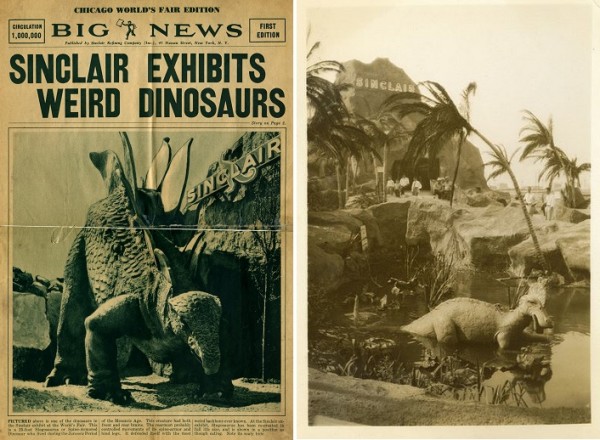
“Sinclair uses dinosaurs in its motor oil adverting to impress on your mind the tremendous age of the crude oils from which Sinclair Motor Oils are made,” proclaimed one Big News article.
The Sinclair dinosaur exhibit drew large crowds once again at the 1936 Texas Centennial Exposition. Four years later, even more visitors marveled at an improved 70-foot dinosaur in Sinclair’s “Dinoland Pavilion” at the 1939-1940 New York World’s Fair.
Sinclair’s green giant and his accompanying cast of Jurassic buddies, including Triceratops, Stegosaurus, a duck-billed Hadrosaurus, and a 20-foot-tall Tyrannosaurus Rex – were again a success, especially among young people.
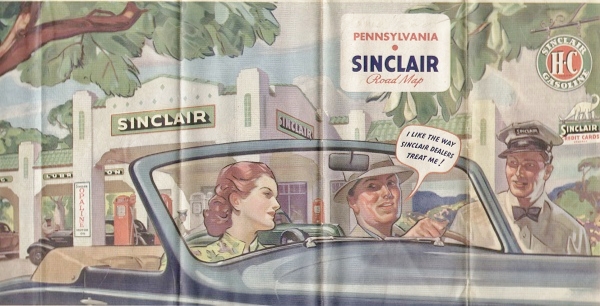
Sinclair’s first super-fuel is marketed in 1926. The “HC” initials stand for “Houston Concentrate,” but some advertising men prefer the term “High Compression.”
Although it was the first U.S. exposition to be based on the future, with an emphasis “the world of tomorrow,” the Sinclair dinosaurs remained a popular attraction among other innovative exhibits. The Westinghouse Company featured “Electro the Moto-Man,” a seven-foot robot that talked and smoked cigarettes.
“Dino” and friends would return to New York City with even greater acclaim in 1964. But it was soon after the Chicago World’s Fair that the oil company recorded its most successful single promotion.
Sinclair Dinosaurs Stamps
In 1935, Sinclair Oil published dinosaur stamps and a stamp album that could be filled only with colored dinosaur stamps — issued one at a time weekly at Sinclair service stations.
The first printing of Sinclair’s dinosaur stamp albums — distributed through its dealers within 48 hours after a single network radio broadcast of the offer — would astound marketing professionals.

In 1935, Sinclair gas stations offered dinosaur stamp albums – and eventually handed out four million albums and 48 million stamps.
“The final totals were 4 million albums and 48 million stamps,” the company noted about its campaign. “Dino” exceeded the other Sinclair Oil Company dinosaurs in becoming an icon of successful petroleum marketing wherever it went.
Refurbished, the 70-foot-long fiberglass green giant and his eight companions — including a large, 45-foot Tyrannosaurus Rex — woul return to New York for another world’s fair in 1964-1965.
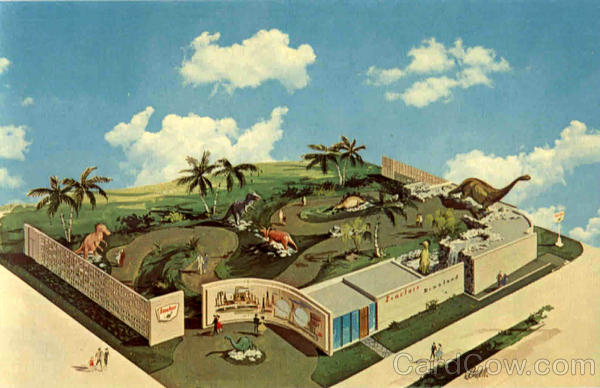
Fifty million New York City visitors attend the 1964-1965 New York World’s Fair – with the Sinclair Corporation’s “Dinoland” exhibition among the most popular of all.
In early 1964, spectators along the Hudson River were amazed to see a barge crowded with an improved Dino and his kin floating downriver. The super-sized reptiles were again bound for a New York World’s Fair. One, Triceritops, was delivered by helicopter.
New York World’s Fair
“For the first time in 70 million years a herd of dinosaurs will travel down the Hudson River this month,” noted the September 1963 issue of Popular Science.
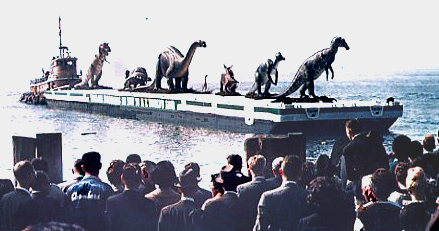
Spectators in 1964 were amazed to see a barge on the Hudson River loaded with dinosaurs.
“Faithfully sculptured and big as life,” noted the magazine, the fiberglass dinosaurs traveled by barge from the Catskill Mountains studio of animal sculptor Louis Paul Jonas, his 18 assistants and paleontologist advisers.
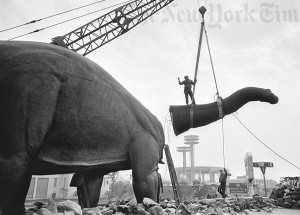
Dismantling of “the great statue that stood in the Sinclair Pavilion of the New York World’s Fair, 1965.” Photo by Robert Walker, the New York Times Archives.
The nine dinosaurs took two months and $250,000 to complete by opening day, April 22, 1964. By the end of the World’s Fair, about 50 million visitors had marvelled at Sinclair’s “Dinoland” exhibit. Dino’s travels did not end when the fair closed in October 1965.

In July 1966, the Sinclair Dinoland exhibit visited Southdale Mall in Edina, Minnesota, where Andy and Doug Ward were photographed by their father David in front of Triceratops. Photo courtesy Doug Ward.
After being disassembled and configured for an extended road trip, Dino began visiting shopping centers and other venues where crowds of children were introduced to the wonders of prehistory, courtesy of Sinclair.
Today, many fair visitors fondly remember another attraction of Sinclair’s Dinoland popular Pavilion – “Mold-A-Rama” machines that dispensed warm, plastic dinosaurs for 25 cents.
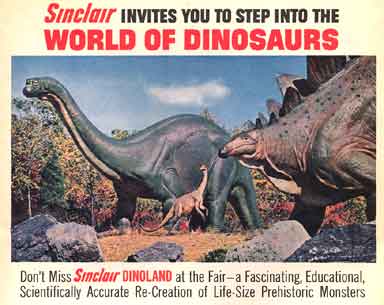
One of the New York World’s Fair dinosaurs would end up in Kansas.
After traveling more 10,000 miles through 25 states and 38 major cities, Dino retired to Dinosaur Valley State Park in Glen Rose, Texas, about 50 miles southwest of Fort Worth. He can still be seen there today. The Texas park contains some of the best preserved dinosaur tracks in the world.

Sinclair Oil Company’s 70-foot Apatosaurus (and a 45-foot Tyrannosaurus Rex) are displayed in Dinosaur Valley State Park, 50 miles southwest of Fort Worth, Texas. Photo courtesy Dinosaur Valley State Park.
“There are two fiberglass models,” the park notes, “a 70-foot Apatosaurus and a 45-foot Tyrannosaurus Rex. They were built, under commission of the Sinclair Oil Company, for New York World’s Fair Dinosaur Exhibit of 1964 – 1965.”
Orginal Corythosaurus in Kansas
Although Sinclair was born in Benwood, West Virginia, today a Wheeling suburb, he grew up in Independence, Kansas. The Historical Museum of Independence educates visitors with an Oil Room exhibiting Sinclair’s extensive Mid-Continent oilfield production and refining heritage.

Sinclair Oil Corporation distributed 48 million dinosaur stamps in a highly successful marketing campaign.
On display in a nearby public park is Corythosaurus – one the dinosaurs from Sinclair’s “Dinoland” exhibit at the 1964-65 New York World’s Fair. The museum’s Old Post Office building was placed on the National Register of Historic Places in 1988.
“The museum’s permanent exhibits in 22 rooms tell stories of the early settler’ lifestyle; the history of the oil industry; some of the Indian Culture collection and various historical artifacts,” explains the Historical Museum of Independence.
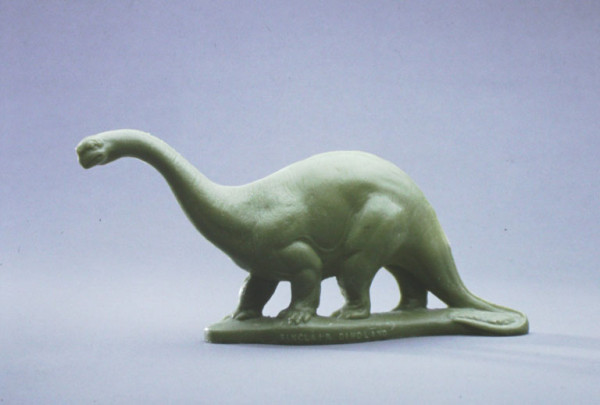
Young New Work World’s Fair visitors recall Sinclair’s “Mold-A-Rama” machine that made a souvenir dinosaur for 25 cents. “See it formed right before your very eyes!” Two sides of a mold came together, producing a still warm plastic dinosaur.
Although later a respected American industrialist, Harry Sinclair was implicated in the Teapot Dome Scandal. Albert Fall, appointed Interior Secretary in 1921 by President Warren G. Harding, was found guilty of accepting a bribe in 1929 — the first cabinet member to be convicted of a felony.
With full control of the Naval Petroleum Reserves, Fall had awarded noncompetitive leases to Sinclair’s Mammoth Oil Company for Teapot Dome oil reserves. Harry Sinclair was acquitted of giving a bribe, but served six-and-a-half months in prison for contempt of court and the U.S. Senate. He died on November 10, 1956.
_______________________
Recommended Reading: The Exciting World of Dinosaurs, Sinclair Dinoland, New York World’s Fair 1964-65 (1958); Teapot Dome Scandal (2009). Your Amazon purchase benefits the American Oil & Gas Historical Society. As an Amazon Associate, AOGHS earns a commission from qualifying purchases.
_______________________
The American Oil & Gas Historical Society (AOGHS) preserves U.S. petroleum history. Become an AOGHS annual supporting member and help maintain this energy education website and expand historical research. For more information, contact bawells@aoghs.org. © 2023 Bruce A. Wells. All rights reserved.
Citation Information – Article Title: “Dinosaur Fever – Sinclair’s Icon.” Authors: B.A. Wells and K.L. Wells. Website Name: American Oil & Gas Historical Society. URL: https://aoghs.org/oil-almanac/sinclair-dinosaur. Last Updated: April 28, 2023. Original Published Date: January 27, 2010.


